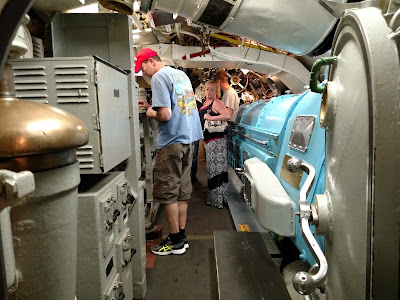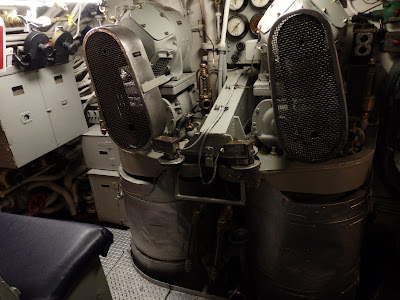One of the worlds longest serving submarines (if not THE longest submarine in service) can be found on the riverfront of Little Rock Arkansas. Originally launched as the USS Razorback in 1944 it served the US Navy in WWII and had an impressive war record.
After WWII it was modernized with a Guppy IIA conversion which made it more hydrodynamic underwater and less able to be be detected. The sail (Conning Tower) was much more streamlined than the WWII configuration.
In 1970 the boat was sold to the Turkish Navy where it was in service until 2001 at which point it was sold and traveled to Little Rock and put on display in 2005.
 |
| This model shows the WWII configuration of the sub |
 |
| Visitors enter the submarine by climbing down a vertical ladder from the main deck into the aft torpedo room |
 |
| The water tight doors between compartments require some interesting body movements to allow easy passage |
 |
| This shows the war history of SS394 including the five red stars indicating pilots rescued after their planes were shot down |
 |
| The Galley |
 |
| View looking down from the sail into the control room |
 |
| Christmas tree board showing red and green lights indicating which openings are still open - All GREEN was required to dive the boat. |
 |
| This is a good view of the more hydrodynamic sail of the USS Razorback in the GUPPY IIA configuration |
Also on display is the Navy Tug boat HOYA (YT-146). This tug was in service at Pearl Harbor and was responsible for a tremendous amount of work after the bombing of the fleet. It help push the battleship NEVADA to beach herself after she made a run for the open ocean and was bombed by the Japanese who hoped to sink her and block the channel into the harbor. The HOYA then fought fires on the burning battleships and rescued sailors from the water.
There is a large and well detailed model of Pearl Harbor in the museum alongside the HOYA which shows the location of the ships at the time of attack and the locations of the HOYA after the battle and during the aftermath. It is most interesting.









































No comments:
Post a Comment